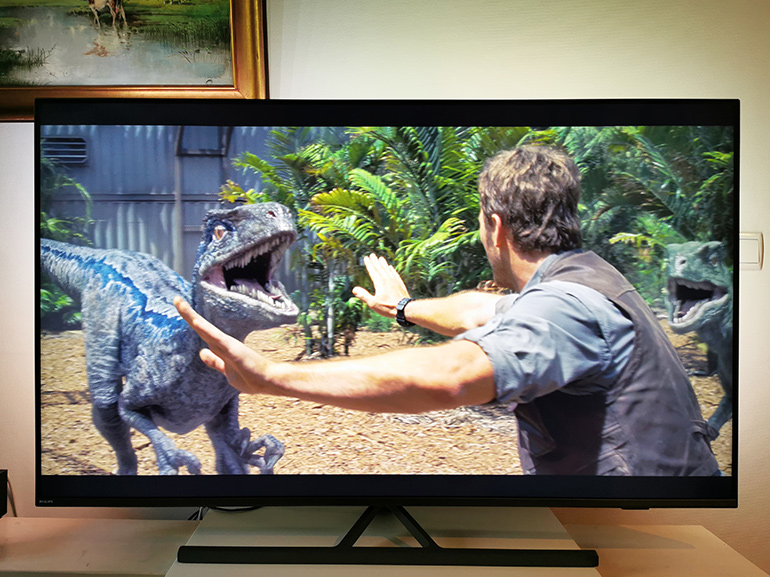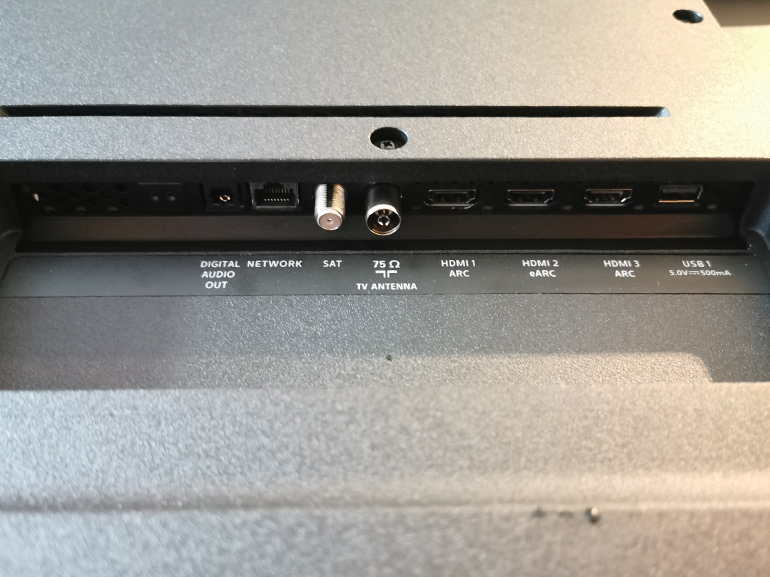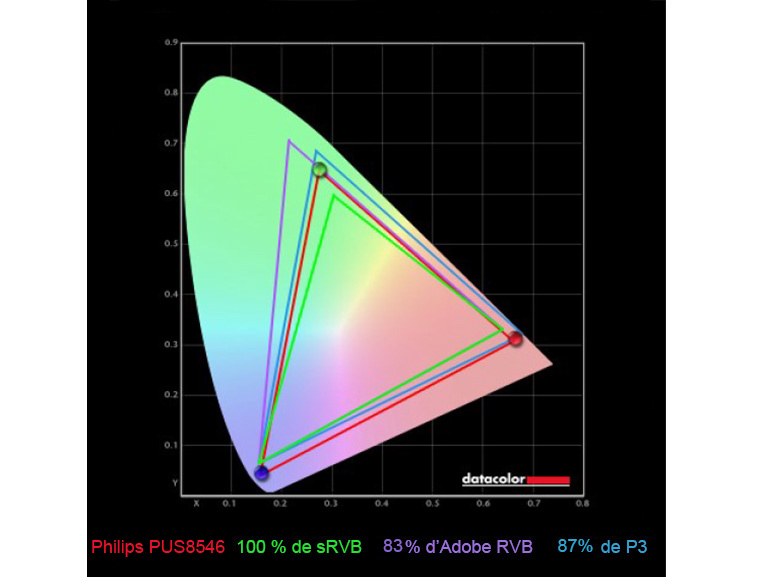The Philips The One range was developed three years ago and has had undeniable success. This third generation picks up the cocktail that has made it so successful: features worthy of a top-of-the-line LCD model at a moderate price. On paper, this model from Chinese TP Vision, owner of the Philips brand, has the good points: a 4K LCD panel, Android TV 10, management of the main HDR processing (HDR10, HDR10+, HLG, Dolby Vision) and HDMI 2.1 -Sockets to take advantage of the latest gaming consoles and eARC. All this for less than 800 euros and with a large diagonal of 58 inches (147 cm). This series also benefits from the dynamic Philips Ambilight lighting system on three sides.
But let’s see what it really is and if this TV really is a good deal. The Philips The One PUS8546 is available in 5 sizes: 43, 50, 58, 65 and 70 inches (109, 127, 147, 165 and 177 cm) at prices between 700 and 1600 euros. We tested the 58-inch (147 cm) model.
A premium design

From the front, this Philips looks like a high-end model with a relatively thin bezel and a 3mm thick metal frame. The TV is 3.1 inches thick without the stand, which is thicker than many of its competitors. On the other hand, this 58 inch TV is quite light, tipping the scales at 20 kg when most 55 inch TVs exceed 25 kg.
The all-metal stand consists of two parts: a 72 cm long spatula at the front and a tab at the back with which the TV can be swiveled 15° to the right or left. The set is very stable, but has a depth of 25.6 cm. Due to these dimensions, it cannot be installed on all TV furniture. Besides, it didn’t work out for us. The TV is 6.5 cm high from the cabinet, which allows the installation of a soundbar. The rear tab has a groove through which the cables can be routed. Rather simple as a system. In addition, the base is not very easy to assemble: it consists of three metal elements that are assembled with the 7 screws provided. We knew it easier…

On the back we notice the three rows of LEDs of the Ambilight system, on both sides and in the upper part of the TV. Invented by Philips, the Ambilight system consists of rows of colored LEDs that energize the picture by projecting a colored light on the wall behind the TV, synchronized with the image on display. We think it’s secondary, but once you get used to the system, it’s hard to let go. In the device settings you can synchronize Ambilight with picture, sound or video games.
It will also be possible to combine Ambilight with connected Philips Hue lights so that your whole room reflects the lighting atmosphere of your programme. The plastic back is slightly curved to accommodate the two 10-watt downward-firing speakers and ports. However, the playback lacks power, space and bass. The TV is compatible with Dolby Atmos and DTS HD titles, but this is just decoding, it will be necessary to use a soundbar or compatible audio system to really take advantage of the 3D spatial effects.

An HDMI 2.1 connection
Philips has equipped its TV with all modern connections: 4 HDMI inputs, including two HDMI 2.1 (HDMI 1 and 2), but without 4K 120p because the panel is limited to 50 Hz. The HDMI 2 socket manages the eARC (Enhanced Return Channel). The HDMI 2.1 inputs ensure compatibility with the latest gaming consoles thanks to advanced features such as ALLM (Auto Low Latency Mode) and in particular VRR (Variable Refresh Rate) to adapt the frame rate of the screen to the console and avoid tearing phenomena. There are also two USB ports (one USB 3.0 and one USB 2.0), two antenna sockets (TNT cable / satellite), an optical digital audio output, a headphone jack and an Ethernet port. Wireless connectivity is provided by Wifi ac and Bluetooth 4.2.
The Philips 58PUS8546 is Chromecast compatible but ignores Apple’s Airplay and Homekit, as well as the Amazon Alexa assistant, which only works via a compatible connected speaker on the TV.

The richness and flexibility of Android TV 10
Philips uses Android TV 10 to animate its TV. This is not the latest version of Google’s operating system. But it offers access to the largest catalog of TV apps. Netflix, Disney+, MyCanal and Prime Video are preinstalled. In addition to the Chromecast function, the device can be controlled by voice via Google Assistant.
To run Android, Philips integrated a Mediatek ARM Cortex-A73 quad-core processor clocked at 1.8 GHz, coupled with a Mali-G52 graphics circuit, 3 GB of RAM and 8 GB of shared storage. From our point of view, this configuration is sufficient for use.

A well thought out remote control
The remote control is very well made, with a brushed aluminum finish and clearly laid out buttons. Its rectangular shape does not affect the grip. As always now, buttons are used to quickly launch Netflix, Amazon Prime Video or Rakuten TV. We would have liked a touch for YouTube or Disney+. Unfortunately, the only backlit button is the one that turns on the Ambilight LEDs, but backlit remotes are only available at the top-end. There’s also a microphone and a button to launch the Google Assistant.

A 50Hz LCD panel
The Philips 58PUS8546 uses a VA LCD panel that displays images in 4K (3840 x 2160 pixels) with a native refresh rate of 50Hz, which is twice as slow as some TVs in the same price range that sometimes hit 100Hz. The Philips P5 processor somehow tries to compensate for the lack of picture fluidity, but the result isn’t convincing: The picture remains jerky, which is noticeable when watching a game, tracking shots or fast action scenes. However, a twist in the motion compensation settings can reduce the damage.
At 1000x magnification, each pixel has three RGB (red, green, blue) primary color sub-pixels.

Cool colors in default mode
Compared to the best LCDs, the Philips 58PUS8546 shows a narrow range of colors (gamut). Our measurements show that it covers 100% of the sRGB color space, but only 87% of the DCI-P3 used by the cinema industry for HDR. For comparison: The TCL 55C728, also equipped with an LCD panel, provided 90 percent coverage of the DCI-P3.
As usual, the color fidelity is not there in standard mode: We measure an average Delta-E of 5.3. However, this reading must be below the threshold of 3 for the human eye to no longer perceive the differences between the colors displayed on the screen and the colors expected. Even with the naked eye, we can see that the image tends toward blue, a blue that appeared to us in the west. The measurements confirm it: The Delta-E of blue is 17…
Switching to Cinema mode keeps colors more realistic with an average Delta-E of 1.5.

A dimly lit but high-contrast image
For an LCD, the Philips 58PUS8546 has a low brightness of 184 cd/m², measured with our probe (in SDR, on the other hand, on the entire screen) by setting the brightness to 100% in standard picture mode. Small reassurance: the contrast ratio reaches 4400:1, thanks to the very deep black at 0.04 cd/m² for an LCD. Even if we are still far from the infinite black of OLED screens, the black level is very satisfactory. It has to be said that the panel is backlit in zones (Full LED Local Dimming), which is also relatively rare at this price.
The device is compatible with many HDR treatments: HDR10, HDR10+, HLG and Dolby Vision. Again, peak brightness is just 302 cd/m², much lower than the higher-end models, which sometimes exceed 1000 cd/m² and 450 cd/m² on some direct competitors like the Samsung Q60A. The gamma curve was measured at 2.3, quite close to our reference curve at 2.2.

Uniformity and viewing angle
Viewing angles are poor, even for an LCD, with severe color and brightness loss when the viewer is off-centre. On the other hand, panel uniformity is comparatively good: tests performed with a probe show that the brightness varies up to a maximum of 13% compared to the center of the screen, with the greatest variation being observed in the top corner.

The competition update
As mentioned above, one of the best competitors of this Philips The One is the Samsung Q60A, but also the TCL C72+, which we also appreciated in our test. There’s also the slightly older but excellent Sony XH90. On the other hand, the latter is much more expensive, so let’s leave it aside.
The Samsung Q60A has the advantage of better brightness, but its contrast ratio is lower. The latter also lacks a 100Hz panel and HDMI 2.1 capability, whereas The One offers several features of this standard. Finally, instead of Android TV, the Samsung embeds Tizen, the brand’s in-house operating system, which also works quite well, even if we prefer Android. For its part, the TCL will offer features close to this Philips, but it has a true native 100Hz panel and full HDMI 2.1 connectivity. It will therefore be perfect for gamers. Its big flaw is also the brightness, which is pretty close to that of The One.
Conclusion
With this latest The One model, Philips wanted to offer a large LCD TV at a competitive price. Despite the low brightness and the 50 Hz panel, this bet is partially held. Well equipped (Android TV, HDMI 2.1, Dolby Vision, Ambilight), this Philips 58PUS8546 shows a beautiful 4K picture with a satisfactory contrast for an LCD. However, we also invite you to consider the TCL C72+, which has similar characteristics and performance, but also includes a 100Hz panel and full HDMI 2.1 connectivity.

